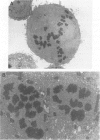Abstract
Hyperthermia is an efficient means of inducing cell death in vivo and in vitro. Among human neoplastic cells, HeLa S3 cells are susceptible to heat injury when exposed to long duration moderate hyperthermia (41.5 C), conditions that are reproducible and sustainable in the clinical setting. Hence, HeLa S3 cells are a useful substrate for evaluation of hyperthermic injury in human neoplasia. Previous studies have demonstrated a consistent response of HeLa S3 cells to moderate hyperthermia: spontaneous premature condensation of chromosomes during heat exposure in S phase followed by apparent nuclear fragmentation and, inevitably, cell death. To further characterize the morphological features of this process, HeLa S3 cells grown in suspension at 37 C were heated for 4, 8, 12, or 16 hours at 41.5 C and harvested in glutaraldehyde for electron microscopic evaluation. Compared with untreated controls, heated samples exhibited a characteristic pattern of chromosome condensation that mimicked mitotic prophase but was followed by haphazard asymmetric segregation of chromatid clusters in abnormal metaphase/anaphase and premature reformation of nuclear membrane, resulting not in nuclear fragmentation, but in multiple micronuclei. This pattern of nuclear morphology was not observed in controls. The fraction of cells with micronuclear morphology increased with time in heated samples (from 3.6% at 4 hours to 16.6% at 16 hours), consistent with previous light microscopic analyses of nuclear fragmentation. Cells with multiple micronuclei subsequently exhibited features similar to necrotic cell death. Apoptosis was never observed. Moderate hyperthermia appears to induce a novel morphological pattern of cell injury and death in HeLa S3 cell lines that may be useful as a means of screening cell lines for nonmorphological analyses of hyperthermic injury.
Full text
PDF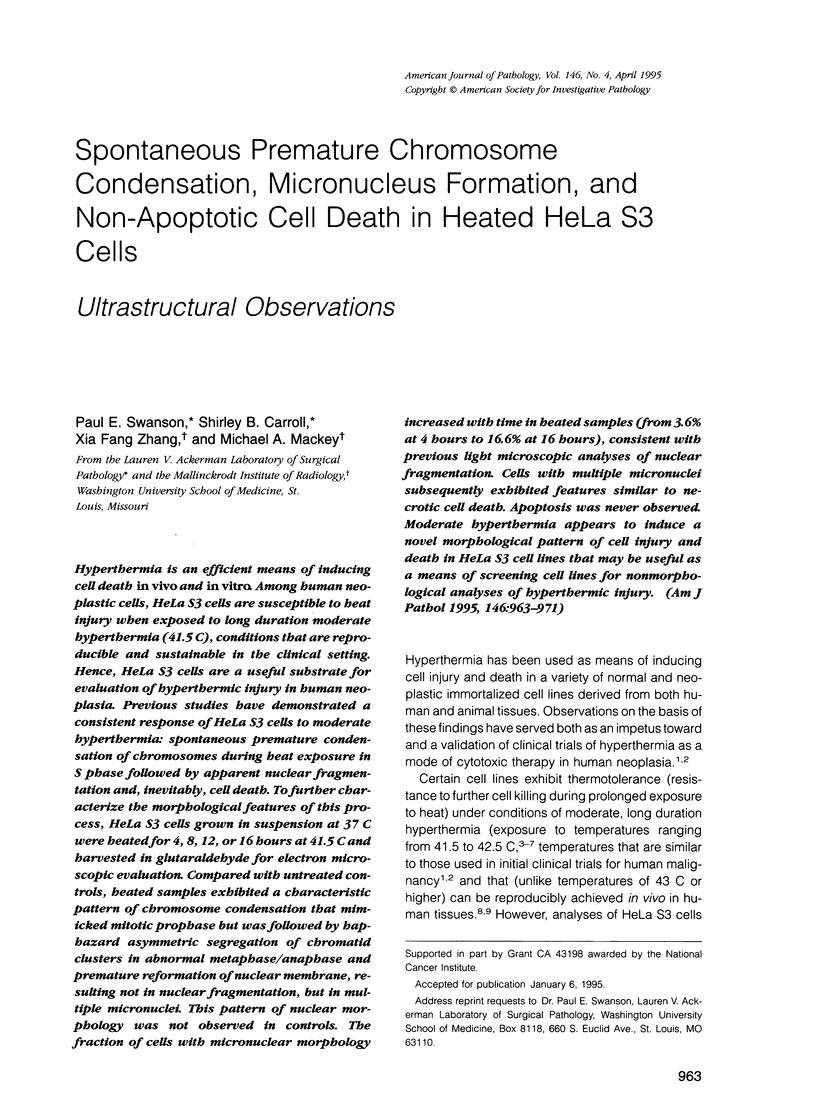
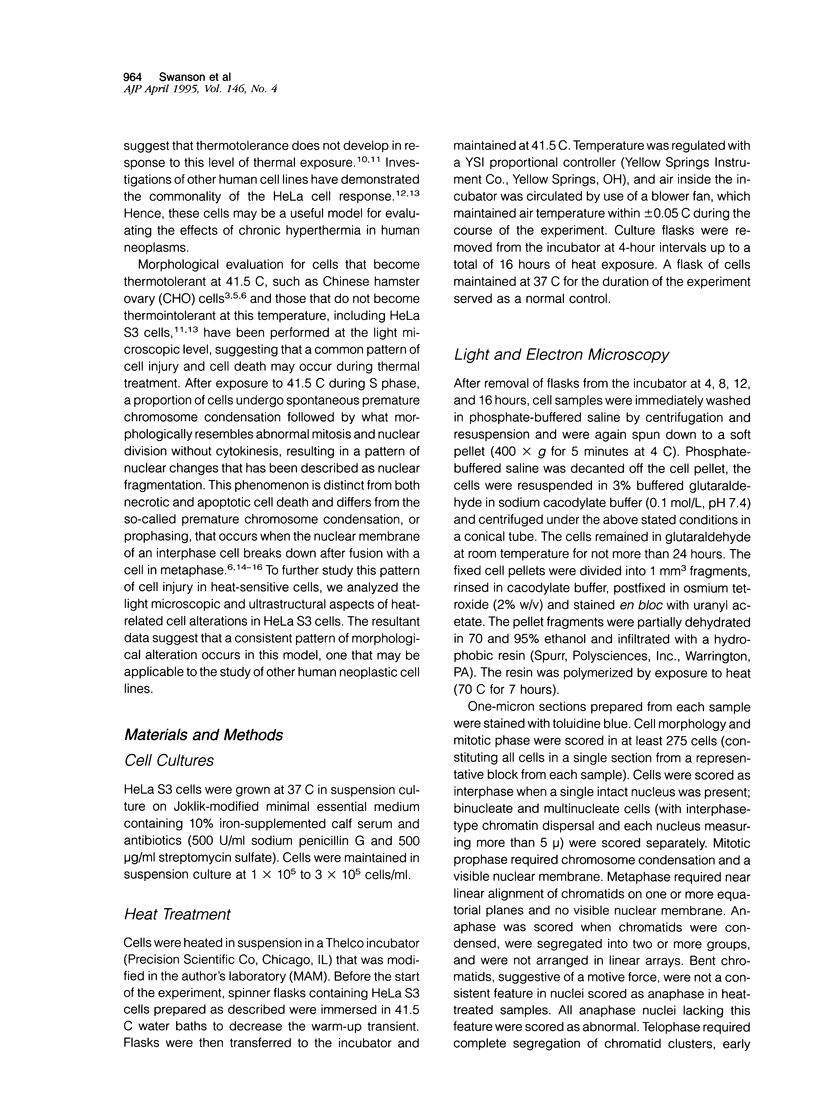
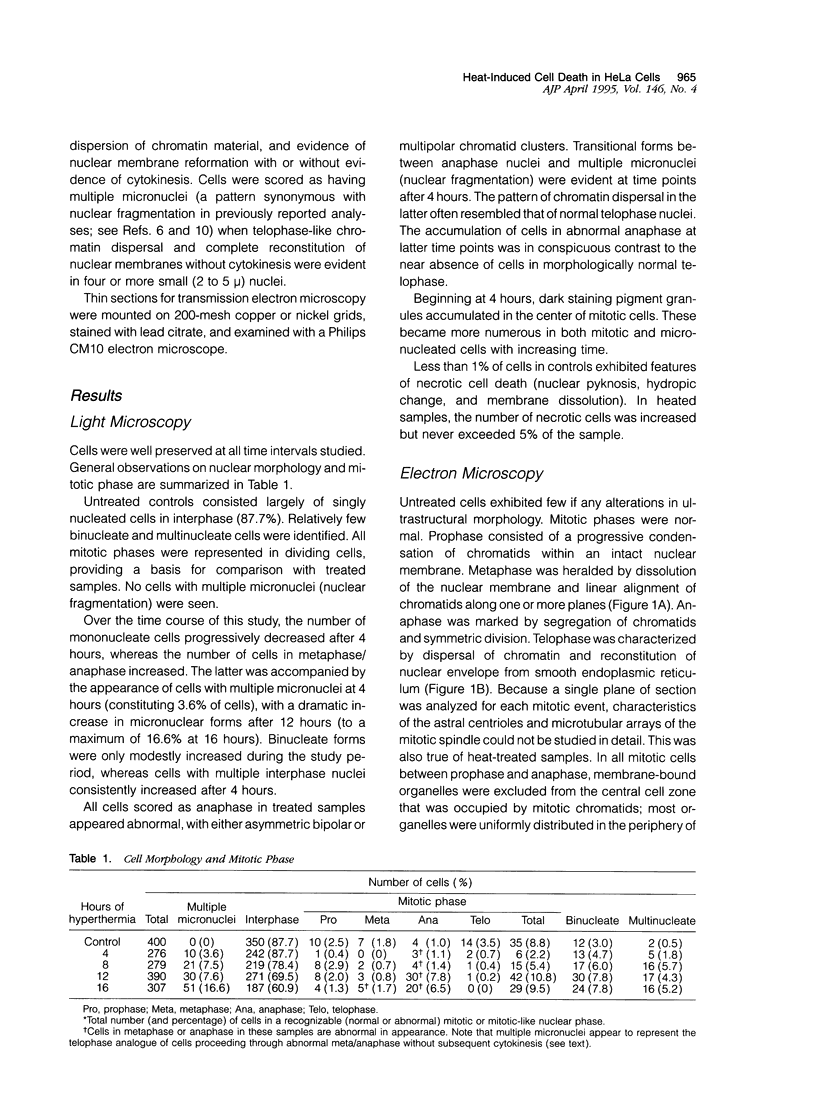
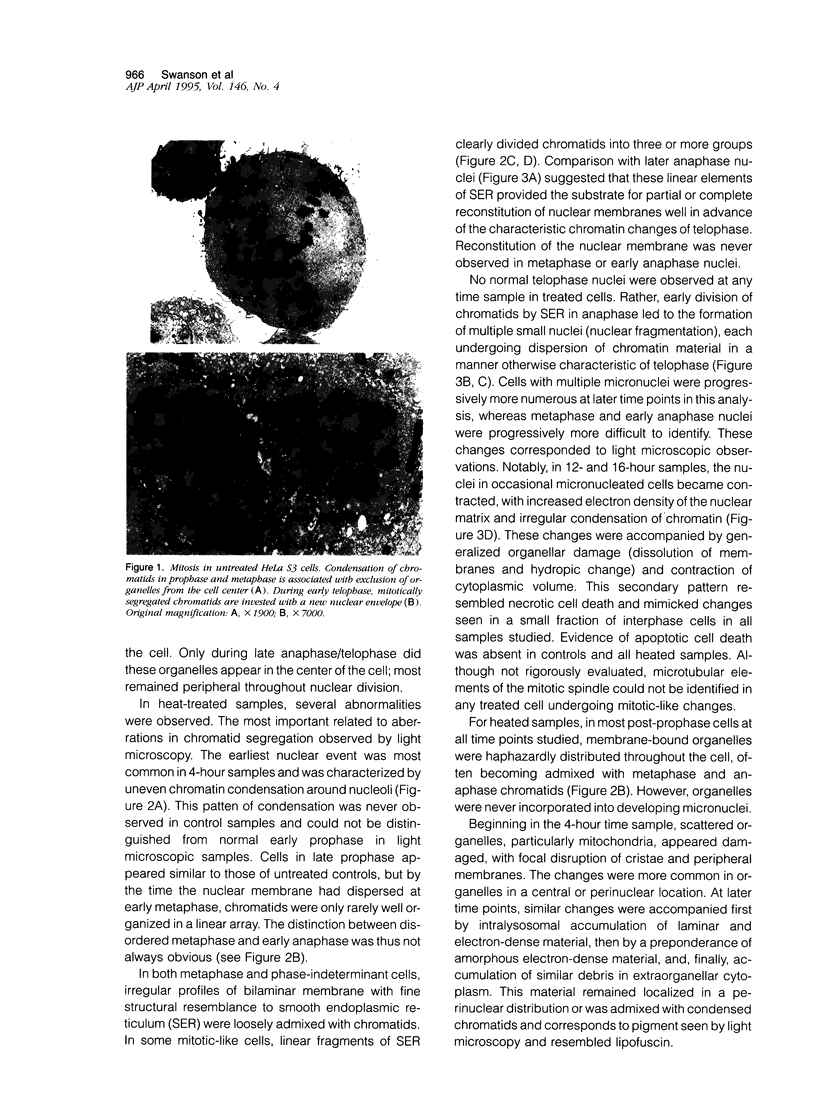
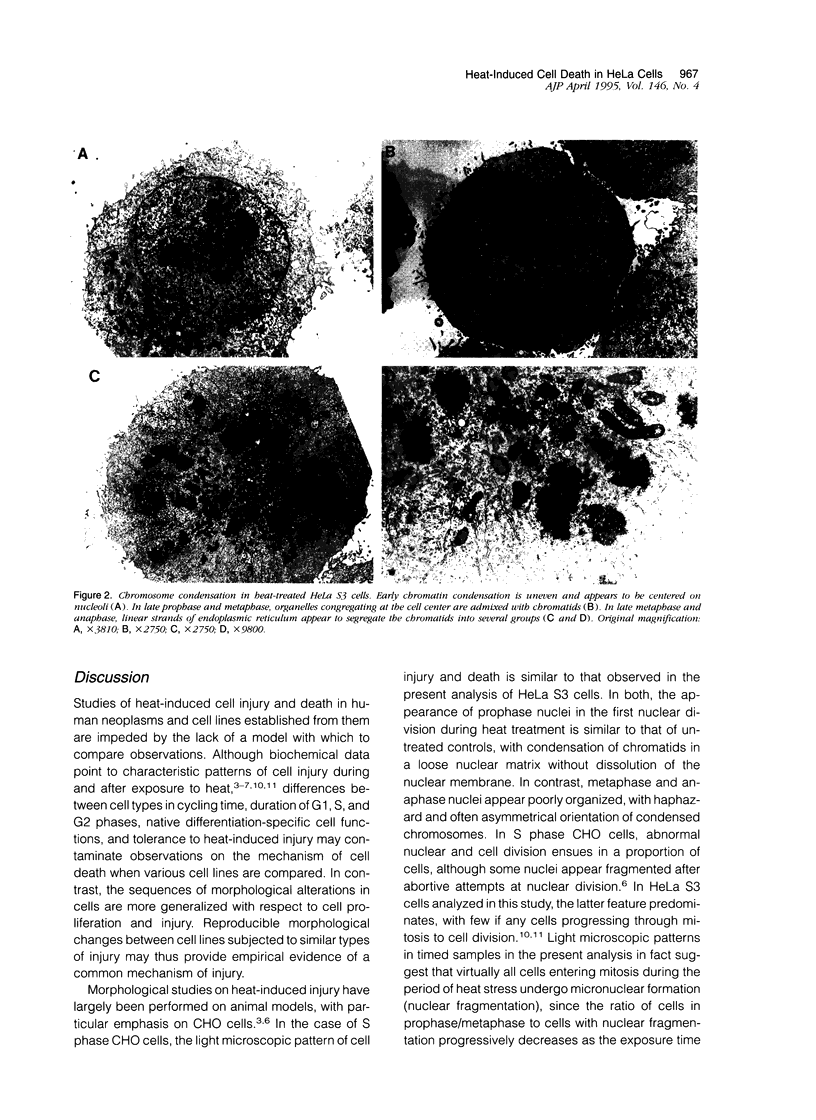
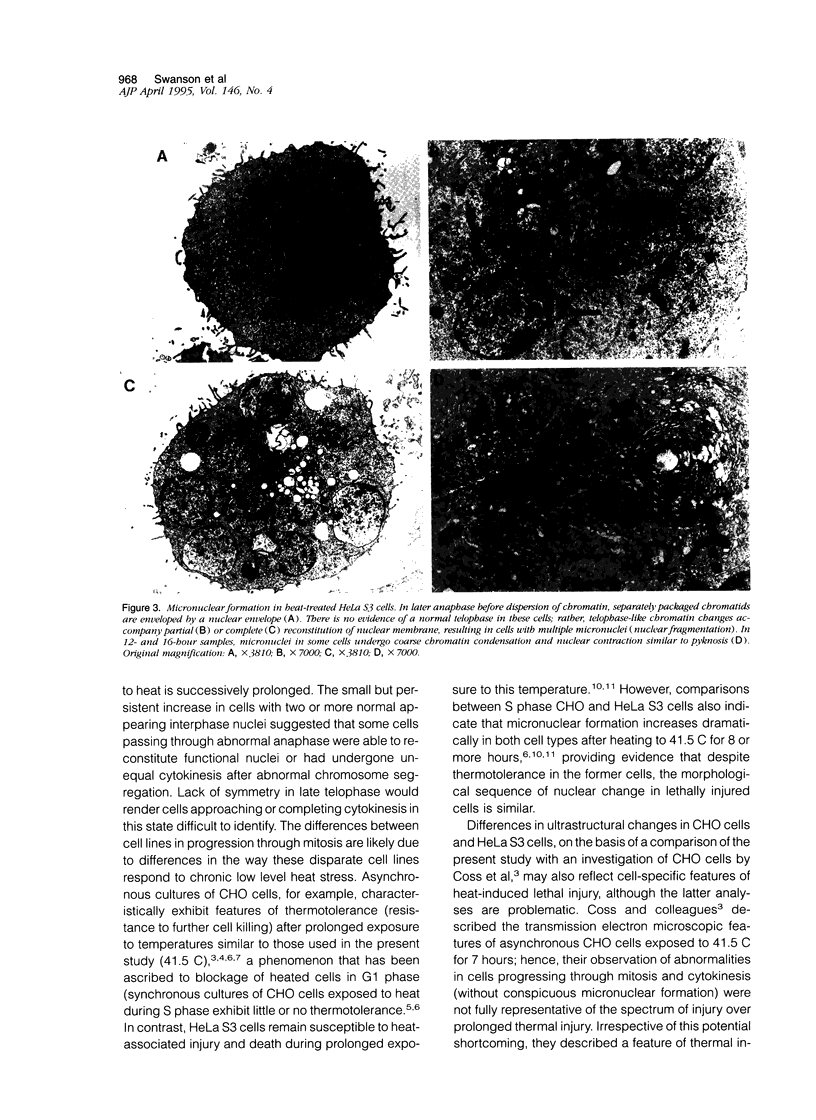
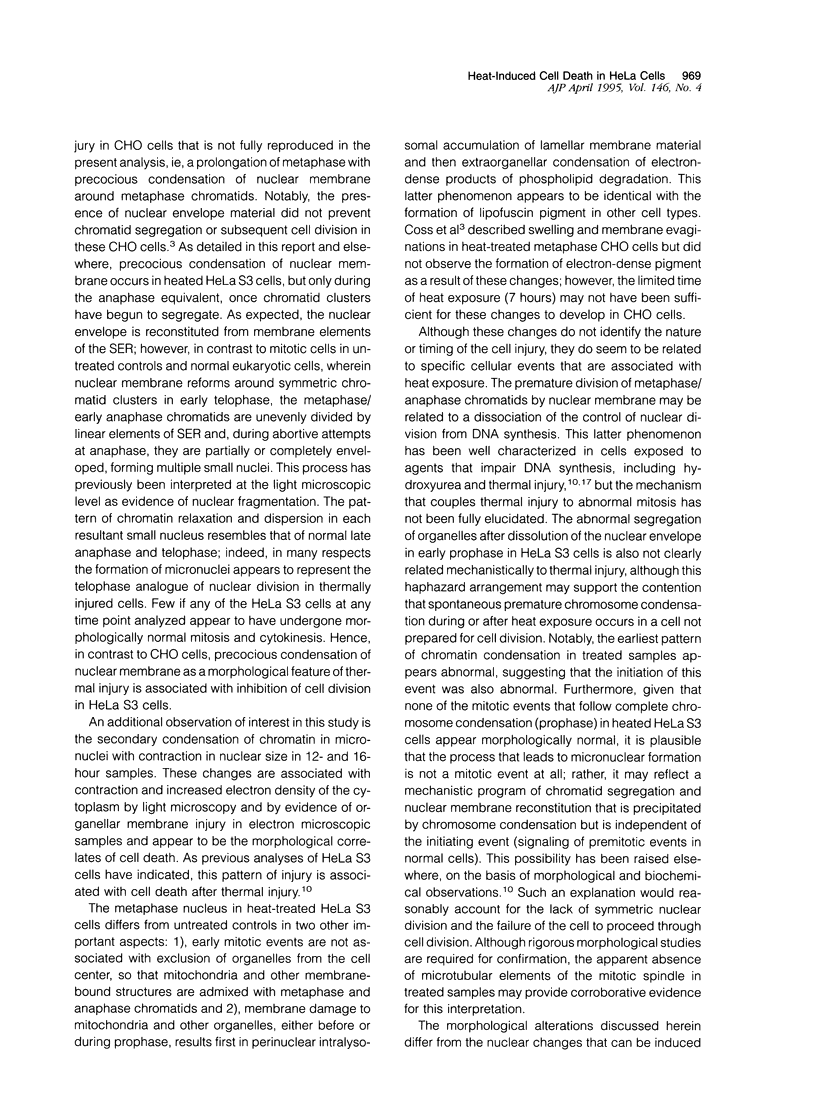
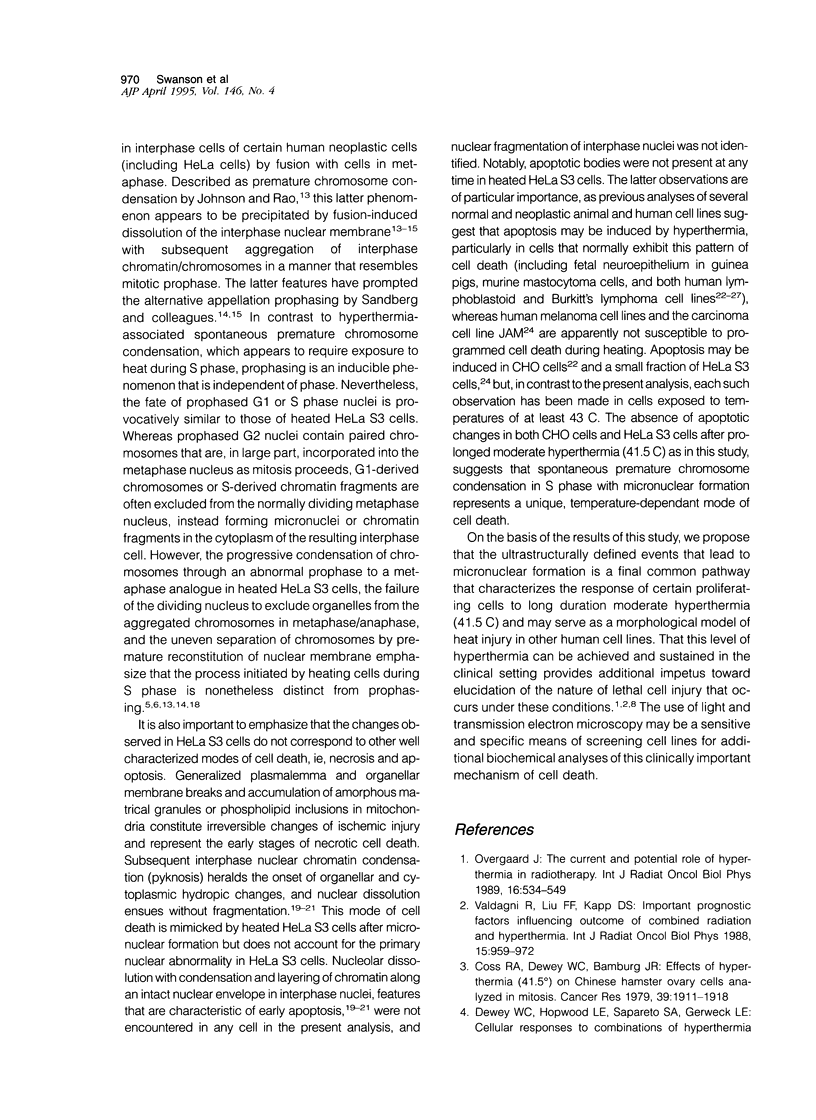
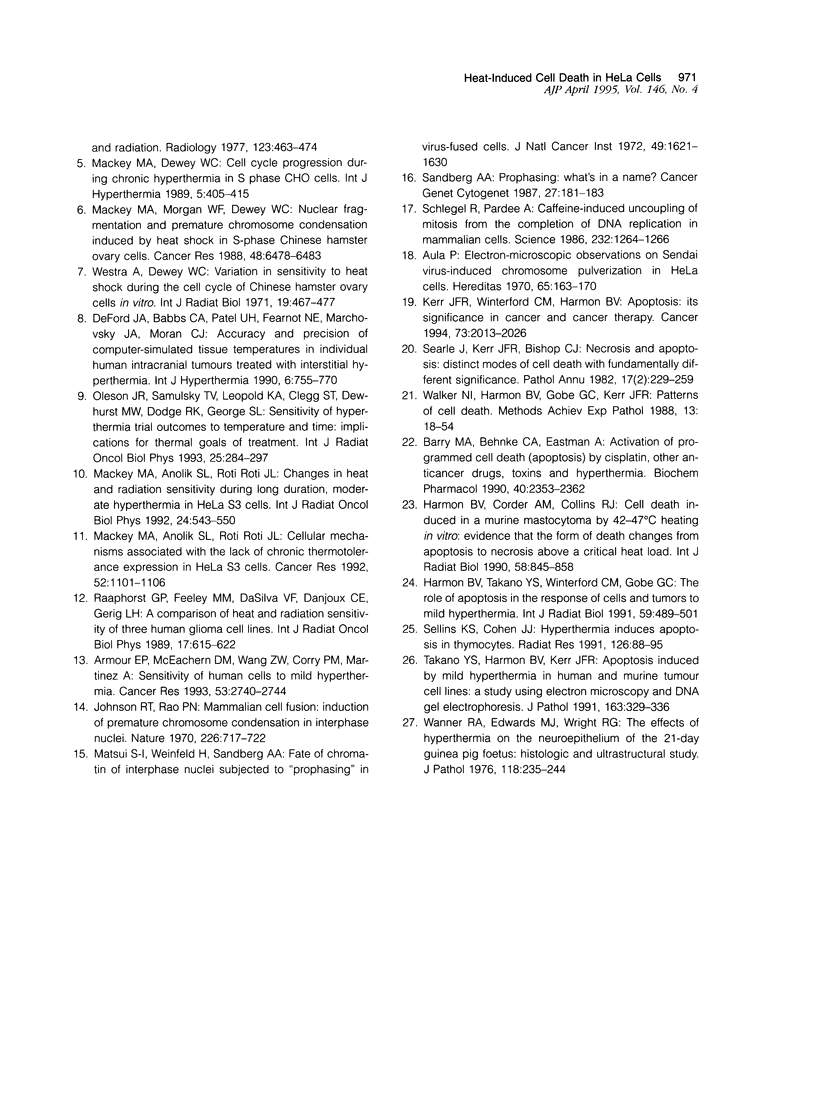
Images in this article
Selected References
These references are in PubMed. This may not be the complete list of references from this article.
- Armour E. P., McEachern D., Wang Z., Corry P. M., Martinez A. Sensitivity of human cells to mild hyperthermia. Cancer Res. 1993 Jun 15;53(12):2740–2744. [PubMed] [Google Scholar]
- Aula P. Electron-microscopic observations on Sendai virus-induced chromosome pulverization in HeLa cells. Hereditas. 1970;65(2):163–169. doi: 10.1111/j.1601-5223.1970.tb02314.x. [DOI] [PubMed] [Google Scholar]
- Barry M. A., Behnke C. A., Eastman A. Activation of programmed cell death (apoptosis) by cisplatin, other anticancer drugs, toxins and hyperthermia. Biochem Pharmacol. 1990 Nov 15;40(10):2353–2362. doi: 10.1016/0006-2952(90)90733-2. [DOI] [PubMed] [Google Scholar]
- Coss R. A., Dewey W. C., Bamburg J. R. Effects of hyperthermia (41.5 degrees) on Chinese hamster ovary cells analyzed in motisis. Cancer Res. 1979 Jun;39(6 Pt 1):1911–1918. [PubMed] [Google Scholar]
- DeFord J. A., Babbs C. F., Patel U. H., Fearnot N. E., Marchosky J. A., Moran C. J. Accuracy and precision of computer-simulated tissue temperatures in individual human intracranial tumours treated with interstitial hyperthermia. Int J Hyperthermia. 1990 Jul-Aug;6(4):755–769. doi: 10.3109/02656739009140823. [DOI] [PubMed] [Google Scholar]
- Harmon B. V., Corder A. M., Collins R. J., Gobé G. C., Allen J., Allan D. J., Kerr J. F. Cell death induced in a murine mastocytoma by 42-47 degrees C heating in vitro: evidence that the form of death changes from apoptosis to necrosis above a critical heat load. Int J Radiat Biol. 1990 Nov;58(5):845–858. doi: 10.1080/09553009014552221. [DOI] [PubMed] [Google Scholar]
- Harmon B. V., Takano Y. S., Winterford C. M., Gobé G. C. The role of apoptosis in the response of cells and tumours to mild hyperthermia. Int J Radiat Biol. 1991 Feb;59(2):489–501. doi: 10.1080/09553009114550441. [DOI] [PubMed] [Google Scholar]
- Johnson R. T., Rao P. N. Mammalian cell fusion: induction of premature chromosome condensation in interphase nuclei. Nature. 1970 May 23;226(5247):717–722. doi: 10.1038/226717a0. [DOI] [PubMed] [Google Scholar]
- Kerr J. F., Winterford C. M., Harmon B. V. Apoptosis. Its significance in cancer and cancer therapy. Cancer. 1994 Apr 15;73(8):2013–2026. doi: 10.1002/1097-0142(19940415)73:8<2013::aid-cncr2820730802>3.0.co;2-j. [DOI] [PubMed] [Google Scholar]
- Mackey M. A., Anolik S. L., Roti Roti J. L. Cellular mechanisms associated with the lack of chronic thermotolerance expression in HeLa S3 cells. Cancer Res. 1992 Mar 1;52(5):1101–1106. [PubMed] [Google Scholar]
- Mackey M. A., Anolik S. L., Roti Roti J. L. Changes in heat and radiation sensitivity during long duration, moderate hyperthermia in HeLa S3 cells. Int J Radiat Oncol Biol Phys. 1992;24(3):543–550. doi: 10.1016/0360-3016(92)91071-t. [DOI] [PubMed] [Google Scholar]
- Mackey M. A., Dewey W. C. Cell cycle progression during chronic hyperthermia in S phase CHO cells. Int J Hyperthermia. 1989 May-Jun;5(3):405–415. doi: 10.3109/02656738909140467. [DOI] [PubMed] [Google Scholar]
- Mackey M. A., Morgan W. F., Dewey W. C. Nuclear fragmentation and premature chromosome condensation induced by heat shock in S-phase Chinese hamster ovary cells. Cancer Res. 1988 Nov 15;48(22):6478–6483. [PubMed] [Google Scholar]
- Matsui S., Weinfeld H., Sandberg A. A. Fate of chromatin of interphase nuclei subjected to "phosphasing" in virus-fused cells. J Natl Cancer Inst. 1972 Dec;49(6):1621–1630. doi: 10.1093/jnci/49.6.1621. [DOI] [PubMed] [Google Scholar]
- Oleson J. R., Samulski T. V., Leopold K. A., Clegg S. T., Dewhirst M. W., Dodge R. K., George S. L. Sensitivity of hyperthermia trial outcomes to temperature and time: implications for thermal goals of treatment. Int J Radiat Oncol Biol Phys. 1993 Jan 15;25(2):289–297. doi: 10.1016/0360-3016(93)90351-u. [DOI] [PubMed] [Google Scholar]
- Overgaard J. The current and potential role of hyperthermia in radiotherapy. Int J Radiat Oncol Biol Phys. 1989 Mar;16(3):535–549. doi: 10.1016/0360-3016(89)90470-7. [DOI] [PubMed] [Google Scholar]
- Raaphorst G. P., Feeley M. M., Da Silva V. F., Danjoux C. E., Gerig L. H. A comparison of heat and radiation sensitivity of three human glioma cell lines. Int J Radiat Oncol Biol Phys. 1989 Sep;17(3):615–622. doi: 10.1016/0360-3016(89)90114-4. [DOI] [PubMed] [Google Scholar]
- Sandberg A. A. Prophasing: what's in a name? Cancer Genet Cytogenet. 1987 Jul;27(1):181–183. doi: 10.1016/0165-4608(87)90274-3. [DOI] [PubMed] [Google Scholar]
- Schlegel R., Pardee A. B. Caffeine-induced uncoupling of mitosis from the completion of DNA replication in mammalian cells. Science. 1986 Jun 6;232(4755):1264–1266. doi: 10.1126/science.2422760. [DOI] [PubMed] [Google Scholar]
- Searle J., Kerr J. F., Bishop C. J. Necrosis and apoptosis: distinct modes of cell death with fundamentally different significance. Pathol Annu. 1982;17(Pt 2):229–259. [PubMed] [Google Scholar]
- Sellins K. S., Cohen J. J. Hyperthermia induces apoptosis in thymocytes. Radiat Res. 1991 Apr;126(1):88–95. [PubMed] [Google Scholar]
- Takano Y. S., Harmon B. V., Kerr J. F. Apoptosis induced by mild hyperthermia in human and murine tumour cell lines: a study using electron microscopy and DNA gel electrophoresis. J Pathol. 1991 Apr;163(4):329–336. doi: 10.1002/path.1711630410. [DOI] [PubMed] [Google Scholar]
- Valdagni R., Liu F. F., Kapp D. S. Important prognostic factors influencing outcome of combined radiation and hyperthermia. Int J Radiat Oncol Biol Phys. 1988 Oct;15(4):959–972. doi: 10.1016/0360-3016(88)90133-2. [DOI] [PubMed] [Google Scholar]
- Walker N. I., Harmon B. V., Gobé G. C., Kerr J. F. Patterns of cell death. Methods Achiev Exp Pathol. 1988;13:18–54. [PubMed] [Google Scholar]
- Wanner R. A., Edwards M. J., Wright R. G. The effect of hyperthermia on the neuroepithelium of the 21-day guinea-pig foetus: histologic and ultrastructural study. J Pathol. 1976 Apr;118(4):235–244. doi: 10.1002/path.1711180406. [DOI] [PubMed] [Google Scholar]
- Westra A., Dewey W. C. Variation in sensitivity to heat shock during the cell-cycle of Chinese hamster cells in vitro. Int J Radiat Biol Relat Stud Phys Chem Med. 1971;19(5):467–477. doi: 10.1080/09553007114550601. [DOI] [PubMed] [Google Scholar]



